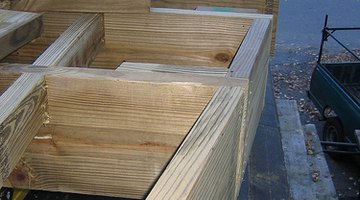How to Bend Trex Decking
Curves on an exterior deck will enhance the overall attractiveness and provide a natural visual quality to the project. Trex decking is a workable option in decking material for homeowners wanting to enhance their deck's distinctiveness. It can bend in a variety of ways to achieve a desired custom look. Not a project to be undertaken lightly, curved decks created with Trex will require extra time for construction and planning, additional materials and a fundamental knowledge of analytical geometry.
How to Bend Trex Decking

Step 1
Once your deck has been framed in place, create a tube-and-heater structure in which to heat your Trex decking (if you do not have another approved heating method). The Trex installation guide provides a diagram on how to construct your own using a portable heater with a fan, rebar, concrete tube and plywood. Depending on your heater selection, you may need to obtain a fuel source such as propane or other natural gas. Build this unit on-site and operate it following all necessary safety precautions.
Step 2
Calculate the radius on your preframed deck that will be needed to attain the desired curve or bend. The radius is typically defined as a line segment from the center of a circle to its perimeter, or half the diameter of a circle. Determining the correct radius for your project will depend upon the circle, oval or curved shape being built. To calculate the radius of a simple circle on site, the Web site Complete Guide to Decks suggests you "build a trammel by anchoring one end of a long 1" x 2" to the center point of the curve with a nail...then measure out along the arm of the trammel a distance equal to the curve radius..."
Step 3
Once the radius has been obtained, use the dimensions that were compiled to build a fixture or "jig" in which to shape your heated Trex decking so as to create the chosen curve or bend. Again, this "jig" will vary according to the deck you are building. In the Trex installation guide, it illustrates the use of a laddered apparatus--a series of shorter boards nailed to two long pieces creating a "ladder"--where wood forms are attached. The wood forms are used to create contact points that the heated Trex decking is pressed against and held in place (by another piece of wood) while cooling.
Step 4
Begin to heat the decking in batches using the tube-and-heater or other approved system. Warm the boards to the required surface-board temperature as recommended by Trex (the temperatures range from 185 to 220 degrees according to the application). Once the decking reaches the required temperature, set the heated decking in the jig, secure so it will retain the desired arc and allow to cool completely. The Trex guide suggests that the cooling process can be hastened by "using a garden hose to spray boards until they are cool to touch."
Step 5
When the shaped board is cool, remove it from the jig for installation. Trex emphasizes the importance of "only removing one board at a time and install[ing] quickly." This is due to the natural tendency for the board to return to its initial (straight) form. Trex also advises that when securing the newly curved decking, you make sure to install the fasteners to the "inside curve" first before affixing additional fasteners to the outer edge.
References
Tips
- Not ready to DIY? Consider hiring a professional.
- Minimum 140,000 BTU heaters are recommended.
- Attach fasteners to the inside of a bend first.
- Have at least two adult helpers.
Warnings
- Trex boards can break during this process.
- Joist spacing must be reduced.
- Bending process is affected by air temperature.
- Read the entire Trex installation guide.
Writer Bio
Mychal Deehn is a freelance writer based in the Carolinas. Her background includes experience in the areas of web and graphic design, residential construction, home maintenance and improvement, animal care and training, general accounting, art, and homeschooling.
Photo Credits
- http://www.flickr.com/photos/kikisdad/ / CC BY 2.0
More Articles



